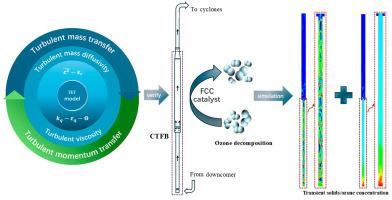具有反应流的循环湍流流化床湍流传质模型
IF 4.3
2区 材料科学
Q2 ENGINEERING, CHEMICAL
引用次数: 0
摘要
循环湍流流化和循环湍流流化床(CTFB)是近二十年来提出的。认为CTFB可以克服循环流化床(CFB)和湍流流化床(TFB)的缺点,同时结合两者高固相循环速率和高固相含率的优点。这些特性对需要连续提取和添加颗粒的反应特别有利。然而,由于难以捕捉内在的细观结构和湍流效应,对CTFB反应流的精确建模和模拟仍然是一个挑战。本文提出了一个紊流传质模型,即双方程紊流(TET)模型,用于CTFB的模拟。TET模型集成了基于能量最小化的多尺度(EMMS)阻力、kq−εq−Θ方法和最近开发的c2¯−εc公式,以严格解释细观结构和湍流效应。利用该模型可以同时得到物料的浓度、相温度、速度和固体体积分数分布。模拟结果与实验数据吻合较好(如典型TET模型模拟与实验的物种浓度分布的平均绝对相对偏差约为8.73%)。这些资料将有助于设计和优化新的CTFB系统或评估现有系统。本文章由计算机程序翻译,如有差异,请以英文原文为准。

A turbulent mass transfer model for circulating turbulent fluidized bed with reactive flow
The circulating turbulent fluidization and circulating turbulent fluidized bed (CTFB) have been proposed over the past two decades. It is believed that CTFB can overcome the disadvantages encountered in circulating fluidized bed (CFB) and turbulent fluidized bed (TFB), while combining their advantages, such as high solids circulation rates and high solids holdup. These characteristics are particularly favorable for reactions requiring continuous particle withdrawal and addition. However, accurate modeling and simulation of CTFB with reactive flow remain challenges primarily due to difficulties in capturing intrinsic meso-structures and the turbulent effects. In this study, a turbulent mass transfer model, namely the two-equation turbulent (TET) model, is proposed for the simulation of CTFB. The TET model integrates the energy minimization multiscale (EMMS)-based drag, the approach and the recently developed formulations to rigorously account for meso-structure and turbulent effects. With this model, the species concentration, phase temperature and velocity as well as solids volume fraction distributions can be obtained simultaneously. Satisfactory agreements between simulated results and experimental data are found (e.g., average absolute relative deviation between a typical simulation by the TET model and experiment on species concentration distributions is about 8.73 %). Such information would be helpful for the design and optimization of a new CTFB system or assessment of an existed one.
求助全文
通过发布文献求助,成功后即可免费获取论文全文。
去求助
来源期刊

Particuology
工程技术-材料科学:综合
CiteScore
6.70
自引率
2.90%
发文量
1730
审稿时长
32 days
期刊介绍:
The word ‘particuology’ was coined to parallel the discipline for the science and technology of particles.
Particuology is an interdisciplinary journal that publishes frontier research articles and critical reviews on the discovery, formulation and engineering of particulate materials, processes and systems. It especially welcomes contributions utilising advanced theoretical, modelling and measurement methods to enable the discovery and creation of new particulate materials, and the manufacturing of functional particulate-based products, such as sensors.
Papers are handled by Thematic Editors who oversee contributions from specific subject fields. These fields are classified into: Particle Synthesis and Modification; Particle Characterization and Measurement; Granular Systems and Bulk Solids Technology; Fluidization and Particle-Fluid Systems; Aerosols; and Applications of Particle Technology.
Key topics concerning the creation and processing of particulates include:
-Modelling and simulation of particle formation, collective behaviour of particles and systems for particle production over a broad spectrum of length scales
-Mining of experimental data for particle synthesis and surface properties to facilitate the creation of new materials and processes
-Particle design and preparation including controlled response and sensing functionalities in formation, delivery systems and biological systems, etc.
-Experimental and computational methods for visualization and analysis of particulate system.
These topics are broadly relevant to the production of materials, pharmaceuticals and food, and to the conversion of energy resources to fuels and protection of the environment.
 求助内容:
求助内容: 应助结果提醒方式:
应助结果提醒方式:


